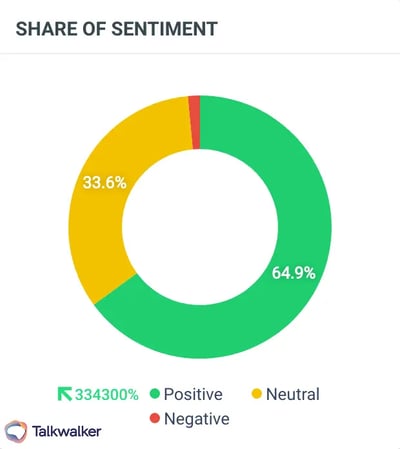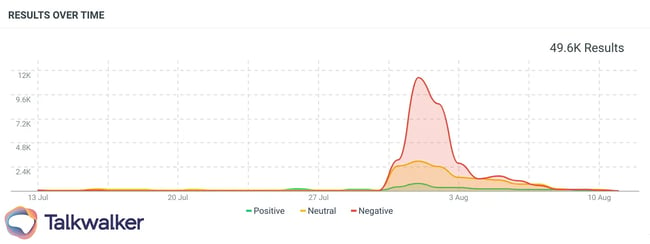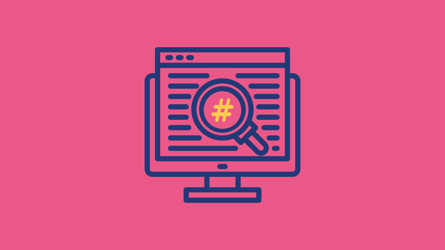A social media crisis, characterized by negative discussions about a brand, can spiral out of control. Quickly creating a threat to your brand's reputation. It's essential for PR & Comms professionals to recognize and handle a genuine social media crisis. But it's equally important to discern what defines a crisis and what doesn’t.
What are social media crises?
Social media crises fall under crisis management. A bona fide social media crisis involves an event that triggers widespread negative sentiment towards your brand. These can pose a significant risk of long-term damage to your reputation. Such crises could stem from product recalls, tasteless executive remarks, or data breaches. The consequences can be devastating, leading to customer attrition, revenue loss, and a breakdown in trust.
These are all examples of a social media crisis.
- Employees going rogue on social media
- A celebrity posting an update that sparks outrage
- A hack into a Twitter account for a major brand
sooo does anyone else not open Snapchat anymore? Or is it just me... ugh this is so sad.
— Kylie Jenner (@KylieJenner) February 21, 2018
The most famous celebrity complaint of all time wiped $1.3 billion off Snap's value. If you or I had posted the same, it would have done nothing.
Check out this blog to find 15 real word social media crisis examples.
What is not an example of a social media crisis?
However, it's important to remember that not all negative incidents on social media equate to a crisis. A lone negative review or sporadic critical comments do not typically precipitate a crisis. For example, a single complaint about delayed delivery or a minor product defect doesn't qualify as a crisis. They’re just customer service issues.
Don’t blow these out of proportion. If you overreact to negative feedback or misjudge a situation's scale, you could make things much worse.
These are not examples of a social media crisis
- Customer service complaint.
- A spike of mentions that are broadly positive.
- Negative reactions to a campaign that’s designed to create negative emotions (“This ad made me so sad”).
- Influencer campaigns where consumers are satisfied with the product but critical of the review style. (In this case, rethinking your influencer strategy may be necessary).
 A sudden spike of mentions may cause panic, but when they're vastly positive, you're safe from a potential crisis. Talkwalker Consumer Intelligence platform.
A sudden spike of mentions may cause panic, but when they're vastly positive, you're safe from a potential crisis. Talkwalker Consumer Intelligence platform.
How to tell what is a social media crisis and what is not
Three things help distinguish between a minor incident and a crisis. The scope, the potential for escalation, and the prospective long-term implications of the situation. Additionally, understanding public sentiment can also be crucial in this context. Is the disapproval widespread, or is it limited to a small group?
What can cause a minor incident to escalate?
Here are some metrics you can monitor to detect if a complaint is at risk of becoming a crisis.
Author reach
An influential author’s complaint is likelier to spread, potentially becoming a significant issue. If someone with 100 followers posts about your bad service, it’s unlikely (but not impossible) that post will spread. But if someone with 1 million fans shares the same complaint, there’s a significant risk that it will spread quickly.
Engagement
How many people are engaging with the social complaint? If the initial engagement is low, it’s likely to fly under the radar. But if a complaint resonates with people, leading to more likes, shares, etc, you should prepare for the worse.
Message pick-up
Sometimes, the simplest complaints go further, not because of what's said, but how it’s said. A witty phrase, clever hashtag, or even a complaint in the form of a song, can drive up the chance of virality. Look for key phrases within complaints, and look to see if others are sharing them. If yes, you may have a viral problem on your hands.
United Breaks Guitars has been viewed 22 million times so far. The same complaint in a Tweet would unlikely gain the same attention.
Sentiment
If people are sharing the initial complaint, sentiment analysis can help you understand if they agree or disagree with the complaint. The internet is a volatile place - will share stuff just so they can disagree with it. By checking the sentiment, you’ll get a better understanding of which side the crowd is on.
Steps to stop a minor incident from becoming a full-blown crisis
So, even with the smallest issues, there is still a potential risk. But you can mitigate that issue by how you react.
- Respond quickly. The longer an issue boils, the hotter it will get. By responding quickly, you can resolve any conflict before it gets too hot to handle. Social listening allows you to hear all your issues as they happen, enabling you to respond faster.
- Take it private. It’s not best to air your dirty washing in the open. Move the conversation into private messages as soon as you can. This allows the complainee to air their complaint fully so you can resolve it. So people don’t think you’re ignoring the issue, make it clear this is happening.
- Communicate the outcome. If the same complaints come up time and again, see if you can create a communication that pre-empts the issues. Consumers just want information. This message could come from your marketing team, or be part of your crisis communications plan.
How can social listening help detect social media crises?
Social listening tools have become pivotal in detecting social media crises by employing real-time monitoring and sophisticated analytics. Here's how these tools can play a critical role:
Real-time monitoring
You should regularly monitor social media conversations by tracking mentions, hashtags, and keywords tied to your brand. You can then analyze both the volume and sentiment of these dialogues in real time. Sudden spikes or unexpected shifts in sentiment could serve as red flags, signaling the need for social media crisis management.
 A large spike of negative mentions should set off alarm bells for any company concerned about its reputation. Talkwalker Consumer Intelligence platform.
A large spike of negative mentions should set off alarm bells for any company concerned about its reputation. Talkwalker Consumer Intelligence platform.
Sentiment analysis
Sentiment analysis is vital in measuring the overall mood toward your brand across social media platforms. Scrutinizing the tone and content of mentions and comments allows you to recognize any significant uptick in negative sentiment. This increased negative sentiment might be a precursor to a crisis, giving you time to act.
Trend analysis
With trend analysis, you can pinpoint emerging subjects and conversations involving your brand. By measuring the pace and volume of these trends, you can detect potential problems that might spiral into a crisis.
Crisis keyword monitoring
Set up custom keyword alerts to monitor specific terms or phrases related to a potential crisis. By keeping tabs on these terms, you'll receive immediate notifications when they surface in social media conversations. This monitoring equips you to respond promptly before a crisis occurs.
Talkwalker's Consumer Intelligence platform
Talkwalker’s consumer intelligence platform encompasses all the features mentioned above, plus more. You can proactively uncover and tackle potential crises, to safeguard your brand's reputation and mitigate the effects of negative situations.
Safeguard your brand reputation in the social media era
Now you know what is not an example of a social media crisis, and what is.
Next time you see a potential issue starting to bubble, take a breath. Then act accordingly with the right, timely response. Click below to learn how Talkwalker helps in a crisis.



